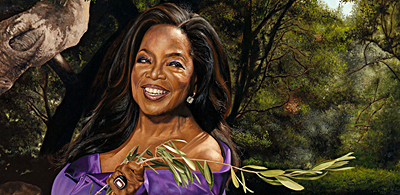The Wal-Mart Museum of Art
In recent years the reach and influence of corporate power in the arts has been steadily growing, and while the super wealthy have always had clout in the art world, we are now looking at a totally different situation. Rather than just providing patronage, corporations are beginning to monopolize and control what was once a public institution… art museums.
That race is being led by The Walton Family Foundation, an organization launched by the family in possession of the largest corporation in the world, Wal-Mart Stores Inc. Fortune Magazine listed Wal-Mart at the top of its 2005 list of the largest five hundred American corporations, placing it above Exxon Mobil, General Motors, Ford Motor Company and General Electric. On Friday May 13th, 2005 (yes, an unlucky day for us all), Wal-Mart heiress Alice L. Walton announced plans that the foundation will open a museum of American art in May 2009 called Crystal Bridges.
The Wal-Mart owned museum, to be located in Bentonville, Arkansas (corporate headquarters for Wal-Mart Stores, Inc.), will house masterworks by Edward Hopper, Winslow Homer, Charles Willson Peale, Charles Bird King, Eastman Johnson, and many others already in the collection of the Walton Family Foundation. Also on Friday the 13th, it was confirmed that the 19th-century painting by Asher B. Durand, Kindred Spirits, was purchased by the Wal-Mart heiress for over $35 million. That’s the largest sum ever paid for an American painting, and Walton outbid the National Gallery of Art and the Metropolitan Museum of Art to acquire it. The 1849 painting by the Hudson River School artist, will now hang in the new Wal-Mart museum.
Crystal Bridges will be home to the Walton family’s permanent collection, which is composed of artworks by American artists from the Revolutionary War period to the modern era. The museum will also loan works as well as present temporary exhibits from national art museums. The Wal-Mart heiress announced through a Friday the 13th press release that she expects “Crystal Bridges to become a major museum of American art and to be a substantial resource for the American public.”
The Wal-Mart billionaire stated the company museum “will present perspectives on the flow of America’s history and heritage through the eyes of the nation’s most influential artists. We hope this museum will build appreciation for America’s artistic heritage.” Those are all very fine words indeed and there’s nothing wrong with the sentiments expressed, however—Wal-Mart Inc. is hardly a credible or benevolent voice when it comes to the public interest, and delivering the nation’s art treasures into its gapping maw makes me shudder.
While the corporate press and apolitical art critics fawn over the art world’s latest benefactor, they are likely to forget to mention the following; Wal-Mart Inc. has a terrible record when it comes to the mistreatment of its US employees, and a ghastly history of exploiting workers in other parts of the world. There is no better example of how politics is intertwined with art than the spectacle of an art museum being founded by a rapacious corporation well known for exporting US jobs overseas and profiting from foreign sweatshop labor. Even CBS news will tell you that Wal-Mart imports more “cheap goods from China than it exports to that country,” and this has led to a loss of at least 400,000 US jobs.
The average American worker at Wal-Mart (the company calls them “associates” rather than workers), earns around $15,000 a year for full time work – and full time work according to Wal-Mart heiress Alice L. Walton and the rest of her billionaire clan, is a paltry 28 hours a week. The majority of workers employed at Wal-Mart don’t even make that much, as they are restricted to “part-time” work (H. Lee Scott Jr, President and CEO of Wal-Mart made $17.5 million in 2005). Wal-Mart offers health care benefits only to workers employed by the company for more than two years – with premiums so high that only a small number of workers can afford coverage.
Wal-Mart is opposed to unionization and has employed all manner of union busting techniques, including firings, to prevent its workers from organizing. There have been numerous allegations of sexual harassment made by women employed at Wal-Mart, as well as a number of legal suits against the company for discriminatory practices against female workers. The New York Times reported Wal-Mart does not promote women fairly, and Business Week reported the company pays women less than men. Sworn testimonies from women currently or formerly employed at Wal-Mart form a litany of outrages. One has to wonder if such miserable working conditions and abusive anti-union policies await the staff of the new Wal-Mart museum.
Aside from abusing its American workers, Wal-Mart is engaged in the brutal exploitation of labor in the under-developed world. From the dreadfulness of the Maquiladora sweatshops in Mexico, Honduras, and Guatemala, to the inhuman factory compounds in Saipan, Pakistan, and China, you’ll find Wal-Mart and its contractors engaged in the most retrograde and vicious anti-labor practices.
This would include child labor, paying workers less than the minimum wage, work days anywhere from 18 to 20 hours long, no days off, no maternity leave (pregnancy is a basis for being fired), forced overtime, denial of health care, monitored bathroom visits, and no right to organize a union. When Wal-Mart pays workers producing clothes in Bangladesh 9 cents an hour, or Honduran workers 43 cents an hour, or Chinese workers 13 cents an hour – is it any wonder Wal-Mart stores can offer low prices?
And there’s something else to take into account when considering the Walton Family Foundation’s self-appointed role of cultural custodians. Wal-Mart knowingly defiled one of humanity’s greatest archeological treasures, the world renowned ancient metropolis of Teotihuakan, located just outside of Mexico City. Constructed over 2000 years ago by indigenous people, Teotihuakan is home to the magnificent Pyramids of the Sun and the Moon.
In December of 2004, Wal-Mart opened one of its super stores in the shadow of Teotihuakan, and its huge parking lot now buries one of the ancient city’s small temples. When those in the Walton Family Foundation who suffer from delusions of grandeur consider themselves to be the protectors of art history, that’s one thing. But when others, especially those in the art world, accept them as guardians of the world’s art treasures… that is nothing short of a travesty.



